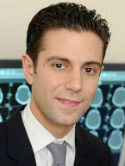Neurologic and oncologic features of Erdheim-Chester disease: A 30-patient series Journal Article
| Authors: | Bhatia, A.; Hatzoglou, V.; Ulaner, G.; Rampal, R.; Hyman, D. M.; Abdel-Wahab, O.; Durham, B. H.; Dogan, A.; Ozkaya, N.; Yabe, M.; Petrova-Drus, K.; Panageas, K. S.; Reiner, A.; Rosenblum, M.; Diamond, E. L. |
| Article Title: | Neurologic and oncologic features of Erdheim-Chester disease: A 30-patient series |
| Abstract: | BACKGROUND: Erdheim-Chester disease (ECD) is a rare histiocytic neoplasm characterized by recurrent alterations in the MAPK (mitogen-activating protein kinase) pathway. The existing literature about the neuro-oncological spectrum of ECD is limited. METHODS: We present retrospective clinical, radiographic, pathologic, molecular, and treatment data from 30 patients with ECD neurohistiocytic involvement treated at a tertiary center. RESULTS: Median age was 52 years (range, 7-77), and 20 (67%) patients were male. Presenting symptoms included ataxia in 19 patients (63%), dysarthria in 14 (47%), diabetes insipidus in 12 (40%), cognitive impairment in 10 (33%), and bulbar affect in 9 (30%). Neurosurgical biopsy specimens in 8 patients demonstrated varied morphologic findings often uncharacteristic of typical ECD lesions. Molecular analysis revealed mutations in BRAF (18 patients), MAP2K1 (5), RAS isoforms (2), and 2 fusions involving BRAF and ALK. Conventional therapies (corticosteroids, immunosuppressants, interferon-alpha [IFN-α], cytotoxic chemotherapy) led to partial radiographic response in 8/40 patients (20%) by MRI with no complete responses, partial metabolic response in 4/16 (25%), and complete metabolic response in 1/16 (6%) by 18F-fluorodeoxyglucose (FDG)-PET scan. In comparison, targeted (kinase inhibitor) therapies yielded partial radiographic response in 10/27 (37%) and complete radiographic response in 14/27 (52%) by MRI, and partial metabolic response in 6/25 (24%) and complete metabolic response in 17/25 (68%) by FDG-PET scan. CONCLUSIONS: These data highlight underrecognized symptomatology, heterogeneous neuropathology, and robust responses to targeted therapies across the mutational spectrum in ECD patients with neurological involvement, particularly when conventional therapies have failed. © The Author(s) 2020. Published by Oxford University Press on behalf of the Society for Neuro-Oncology. All rights reserved. For permissions, please e-mail: journals.permissions@oup.com. |
| Keywords: | central nervous system; targeted therapy; histiocytosis; mapk pathway; erdheim–chester disease |
| Journal Title: | Neuro-Oncology |
| Volume: | 22 |
| Issue: | 7 |
| ISSN: | 1522-8517 |
| Publisher: | Oxford University Press |
| Date Published: | 2020-07-01 |
| Start Page: | 979 |
| End Page: | 992 |
| Language: | English |
| DOI: | 10.1093/neuonc/noaa008 |
| PUBMED: | 31950179 |
| PROVIDER: | scopus |
| PMCID: | PMC7339889 |
| DOI/URL: | |
| Notes: | Article -- Export Date: 3 August 2020 -- Source: Scopus |
Altmetric
Citation Impact
BMJ Impact Analytics
MSK Authors
Related MSK Work


















